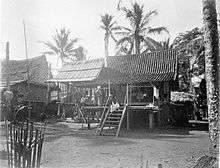Napal Licin

Napal Licin, sometimes written as Napal Litjin from the Dutch East Indies era, is a location in south Sumatra that was visited by European explorers at the end of the 19th century.[1] A cave in the area, Napal Licin Cave, features stalactites and stalagmites and is a tourist attraction that can be reached by boat up the Rawas River,[2][3] a tributary of the Musi River.
Henry Ogg Forbes reached Napal Licin during his expedition to central Sumatra. He described it as a picturesque village at the base of a perpendicular limestone peak, Karang-nata (Karang Nato). He climbed it, describing the caves with stalactites and thousands of bats he encountered, as well as ferns, orchids, and a species of Boea. He also found a species of nutmeg with fruit "as large as the largest orange". He also found ants "milking" a Hemipteron which produced droplets for them.[4]
Gallery
-

Portrait of girl in Napal Litjin, Djambi Residency (Jambi) by Daniël David Veth (circa 1878)
-

A native of Napal Litjin Palembang Uplands district Rawas Sumatra
-

"Batang Koeloes" at Napal Litjin district, Rawas, Sumatra
-

Man and boy in Napal Litjin
-

A rope spinner
-

A girl
See also
- Theloderma licin, a species of frog
- Musi Rawas
- Kerinci Seblat National Park
References
- ↑ Journal of the Asiatic Society of Bengal, Volume 66 Asiatic Society (Kolkata, India 1897 page 471
- ↑ Napal Licin Cave South Sumatra Tourism
- ↑ Napal Licin Cave Indonesia Tourism
- ↑ A naturalist's wanderings in the Eastern archipelago: a narrative of travel and exploration from 1878 to 1883 Henry Ogg Forbes, Harper & brothers, 1885 page 250, 251, 279
Coordinates: 2°47′38″S 102°14′42″E / 2.7940°S 102.2450°E